栈和队列
- 1.栈
- 1.1栈的概念和结构
- 1.2栈的实现
- 2.队列
- 2.1队列的概念和结构
- 2.2队列的实现
1.栈
1.1栈的概念和结构
栈:一种特殊的线性表,其只允许在固定的一端进行插入和删除元素操作。进行数据插入和删除操作的一端称为栈顶,另一端称为栈底。栈中的数据元素遵守后进先出LIFO(Last In First Out)的原则。
压栈:栈的插入操作叫做进栈/压栈/入栈,入数据在栈顶。
出栈:栈的删除操作叫做出栈。出数据也在栈顶。

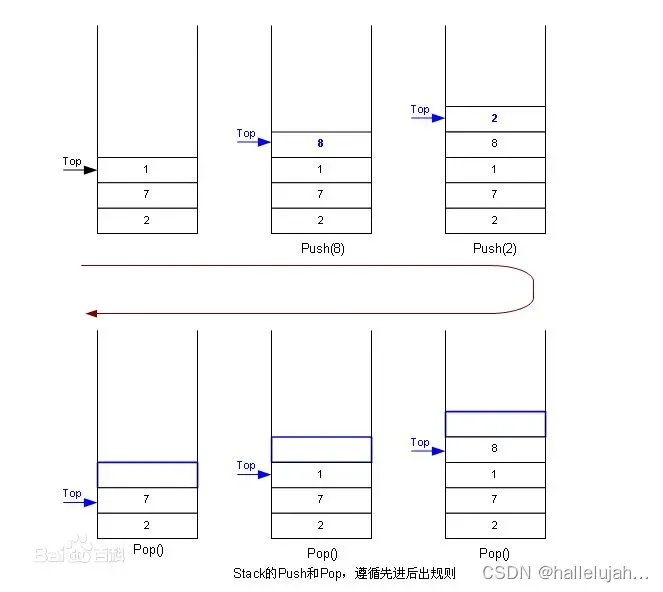
1.2栈的实现
栈的实现一般可以使用数组或者链表实现,相对而言数组的结构实现更优一些。因为数组在尾上插入数据的代价比较小


Stack.h
#include<stdio.h>
#include<stdlib.h>
#include<assert.h>
#include<stdbool.h>
typedef int STDateType;
typedef struct Stack
{
STDateType* a;
int top;
int capacity;
}ST;
//初始化
void STInit(ST* ps);
//销毁
void STDestroy(ST* ps);
//入栈
void STPush(ST* ps, STDateType x);
//出栈
void STPop(ST* ps);
//栈顶
STDateType SLTTop(ST* ps);
//计算大小
int STSize(ST* ps);
//判断是否为空
bool STEmpty(ST* ps);
Stack.c
#include"Stack.h"
//初始化
void STInit(ST* ps)
{
assert(ps);
ps->capacity = NULL;
ps->a = 0;
ps->top = 0;
}
//销毁
void STDestroy(ST* ps)
{
assert(ps);
free(ps->a);
ps->a = NULL;
ps->capacity = ps->top = 0;
}
//入栈
void STPush(ST* ps, STDateType x)
{
assert(ps);
if (ps->top == ps->capacity)
{
int NewCapacity = ps->capacity == 0 ? 4 : ps->capacity * 2;
STDateType* tmp = (STDateType*)realloc(ps->a, sizeof(STDateType) * NewCapacity);
if (tmp == NULL)
{
perror("realloc fail");
exit(-1);
}
ps->a = tmp;
ps->capacity = NewCapacity;
}
ps->a[ps->top] = x;
ps->top++;
}
//出栈
void STPop(ST* ps)
{
assert(ps);
assert(ps->a > 0);
--ps->top;
}
//栈顶
STDateType STTop(ST* ps)
{
assert(ps);
assert(ps->a > 0);
return ps->a[ps->top - 1];
}
//计算
int STSize(ST* ps)
{
assert(ps);
return ps->top;
}
//判断是否为空
bool STEmpty(ST* ps)
{
assert(ps);
return ps->top == NULL;
}
test.c
#include"Stack.h"
void TestStack()
{
ST st;
STInit(&st);
STPush(&st, 1);
STPush(&st, 2);
STPush(&st, 3);
STPush(&st, 4);
STPush(&st, 5);
while (!STEmpty(&st))
{
printf("%d ", STTop(&st));
STPop(&st);
}
printf("\n");
STDestroy(&st);
}
int main()
{
TestStack();
return 0;
}
2.队列
2.1队列的概念和结构
队列:只允许在一端进行插入数据操作,在另一端进行删除数据操作的特殊线性表,队列具有先进先出FIFO(First In First Out) 入队列:进行插入操作的一端称为队尾出队列:进行删除操作的一端称为队头

2.2队列的实现
队列也可以数组和链表的结构实现,使用链表的结构实现更优一些,因为如果使用数组的结构,出队列在数组头上出数据,效率会比较低。
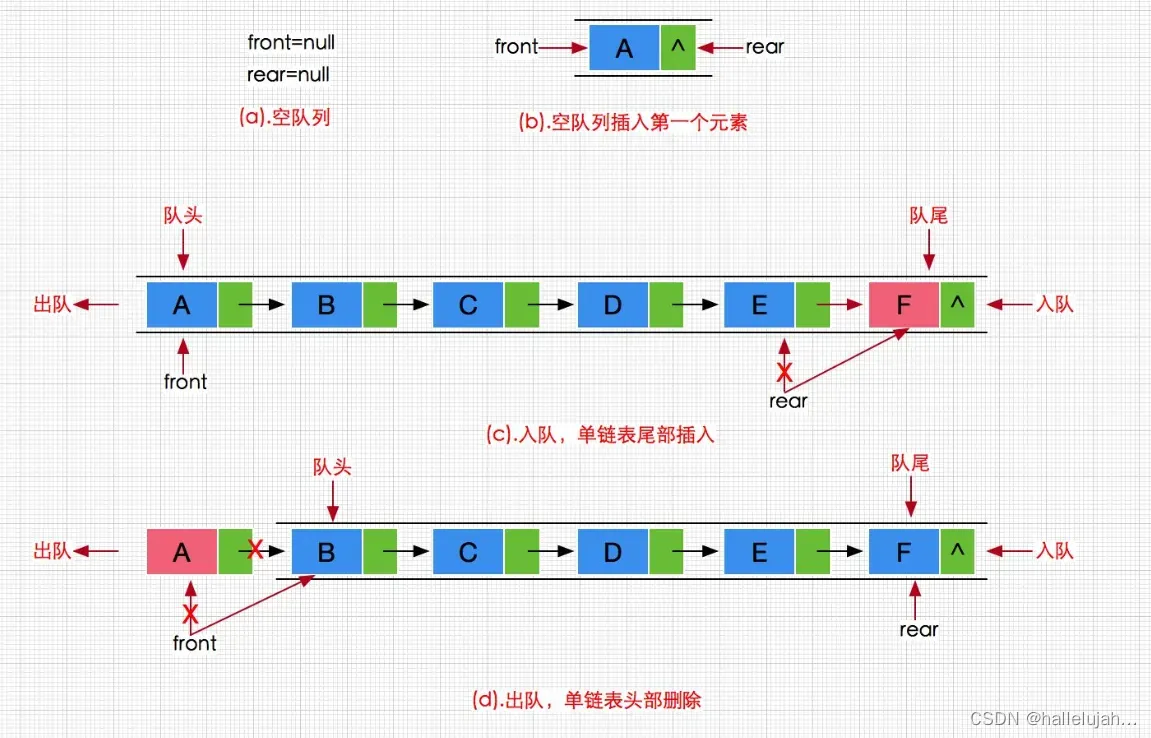
Queue.h
#include<stdio.h>
#include<stdlib.h>
#include<assert.h>
#include<stdbool.h>
typedef int QDataType;
typedef struct QueueNode
{
struct QueueNode* next;
QDataType data;
}QNode;
typedef struct Queue
{
QNode* head;
QNode* tail;
int size;
}Que;
void QueueInit(Que* pq);
void QueueDestroy(Que* pq);
void QueuePush(Que* pq, QDataType x);
void QueuePop(Que* pq);
QDataType QueueFront(Que* pq);
QDataType QueueBack(Que* pq);
bool QueueEmpty(Que* pq);
int QueueSize(Que* pq);
Queue.c
#include"Queue.h"
//初始化
void QueueInit(Que* pq)
{
assert(pq);
pq->head = pq->tail = NULL;
pq->size = 0;
}
//销毁
void QueueDestroy(Que* pq)
{
assert(pq);
QNode* cur = pq->head;
while (cur)
{
QNode* next = cur->next;
free(cur);
cur = cur->next;
}
pq->head = pq->tail = NULL;
pq->size = 0;
}
//入队
void QueuePush(Que* pq, QDateType x)
{
assert(pq);
QNode* newnode = (QNode*)malloc(sizeof(QNode));
if (newnode == NULL)
{
perror("malloc fail");
exit(-1);
}
newnode->date = x;
newnode->next = NULL;
if (pq->tail == NULL)
{
pq->head = pq->tail = newnode;
}
else
{
pq->tail->next = newnode;
pq->tail = newnode;
}
pq->size++;
}
//出队
void QueuePop(Que* pq)
{
assert(pq);
assert(!QueueEmpty(pq));
if (pq->head->next == NULL)
{
pq->head = pq->tail = NULL;
}
else
{
QNode* next = pq->head->next;
free(pq->head);
pq->head = next;
}
pq->size--;
}
//队头
QDateType QueueFront(Que* pq)
{
assert(pq);
assert(!QueueEmpty(pq));
return pq->head->date;
}
//队尾
QDateType QueueBack(Que* pq)
{
assert(pq);
assert(!QueueEmpty);
return pq->tail->date;
}
//判断是否为空
bool QueueEmpty(Que* pq)
{
assert(pq);
return pq->head == NULL;
}
//计算
int QueueSize(Que* pq)
{
assert(pq);
return pq->size;
}
test.c
#include"Queue.h"
void QueueTest()
{
Que pq;
QueueInit(&pq);
QueuePush(&pq, 1);
QueuePush(&pq, 2);
QueuePush(&pq, 3);
QueuePush(&pq, 4);
while (!QueueEmpty(&pq))
{
printf("%d ", QueueFront(&pq));
QueuePop(&pq);
}
printf("\n");
QueueDestroy(&pq);
}
int main()
{
QueueTest();
return 0;
}
3.栈和队列面试题
3.1括号匹配问题
OJ
#include<stdio.h>
#include<stdlib.h>
#include<assert.h>
#include<stdbool.h>
//有效括号
typedef char STDateType;
typedef struct Stack
{
STDateType* a;
int top;
int capacity;
}ST;
//初始化
void STInit(ST* ps);
//销毁
void STDestroy(ST* ps);
//入栈
void STPush(ST* ps, STDateType x);
//出栈
void STPop(ST* ps);
//栈顶
STDateType SLTTop(ST* ps);
//计算大小
int STSize(ST* ps);
//判断是否为空
bool STEmpty(ST* ps);
//初始化
void STInit(ST* ps)
{
assert(ps);
ps->capacity = NULL;
ps->a = 0;
ps->top = 0;
}
//销毁
void STDestroy(ST* ps)
{
assert(ps);
free(ps->a);
ps->a = NULL;
ps->capacity = ps->top = 0;
}
//入栈
void STPush(ST* ps, STDateType x)
{
assert(ps);
if (ps->top == ps->capacity)
{
int NewCapacity = ps->capacity == 0 ? 4 : ps->capacity * 2;
STDateType* tmp = (STDateType*)realloc(ps->a, sizeof(STDateType) * NewCapacity);
if (tmp == NULL)
{
perror("realloc fail");
exit(-1);
}
ps->a = tmp;
ps->capacity = NewCapacity;
}
ps->a[ps->top] = x;
ps->top++;
}
//出栈
void STPop(ST* ps)
{
assert(ps);
assert(ps->a > 0);
--ps->top;
}
//栈顶
STDateType STTop(ST* ps)
{
assert(ps);
assert(ps->a > 0);
return ps->a[ps->top - 1];
}
//计算
int STSize(ST* ps)
{
assert(ps);
return ps->top;
}
//判断是否为空
bool STEmpty(ST* ps)
{
assert(ps);
return ps->top == NULL;
}
bool isValid(char* s)
{
ST st;
STInit(&st);
char topVal;
while (*s)
{
//数量不匹配
if (*s == '(' || *s == '[' || *s == '{')
{
STPush(&st, *s);
}
else
{
if (STEmpty(&st))
{
STDestroy(&st);
return false;
}
topVal = STTop(&st);
STPop(&st);
if ((*s == ')' && topVal != '(') || (*s == ']' && topVal != '[') || (*s == ' }' && topVal != '{'))
{
STDestroy(&st);
return false;
}
}
s++;
}
//栈不为空,false,说明数量不匹配
bool ret = STEmpty(&st);
STDestroy(&st);
return ret;
}
int main()
{
isValid("[(({})}]");#include<stdio.h>
#include<stdlib.h>
#include<assert.h>
#include<stdbool.h>
typedef int STDateType;
typedef struct Stack
{
STDateType* a;
int top;
int capacity;
}ST;
//初始化
void STInit(ST* ps);
//销毁
void STDestroy(ST* ps);
//入栈
void STPush(ST* ps, STDateType x);
//出栈
void STPop(ST* ps);
//栈顶
STDateType SLTTop(ST* ps);
//计算大小
int STSize(ST* ps);
//判断是否为空
bool STEmpty(ST* ps);
//初始化
void STInit(ST* ps)
{
assert(ps);
ps->capacity = NULL;
ps->a = 0;
ps->top = 0;
}
//销毁
void STDestroy(ST* ps)
{
assert(ps);
free(ps->a);
ps->a = NULL;
ps->capacity = ps->top = 0;
}
//入栈
void STPush(ST* ps, STDateType x)
{
assert(ps);
if (ps->top == ps->capacity)
{
int NewCapacity = ps->capacity == 0 ? 4 : ps->capacity * 2;
STDateType* tmp = (STDateType*)realloc(ps->a, sizeof(STDateType) * NewCapacity);
if (tmp == NULL)
{
perror("realloc fail");
exit(-1);
}
ps->a = tmp;
ps->capacity = NewCapacity;
}
ps->a[ps->top] = x;
ps->top++;
}
//出栈
void STPop(ST* ps)
{
assert(ps);
assert(ps->a > 0);
--ps->top;
}
//栈顶
STDateType STTop(ST* ps)
{
assert(ps);
assert(ps->a > 0);
return ps->a[ps->top - 1];
}
//计算
int STSize(ST* ps)
{
assert(ps);
return ps->top;
}
//判断是否为空
bool STEmpty(ST* ps)
{
assert(ps);
return ps->top == NULL;
}
typedef struct
{
ST pushst;
ST popst;
} MyQueue;
MyQueue* myQueueCreate()
{
MyQueue* obj = (MyQueue*)malloc(sizeof(MyQueue));
STInit(&obj->popst);
STInit(&obj->pushst);
return obj;
}
void myQueuePush(MyQueue* obj, int x)
{
STPush(&obj->pushst, x);
}
int myQueuePeek(MyQueue* obj)
{
if (STEmpty(&obj->popst))
{
while (!STEmpty(&obj->pushst))
{
STPush(&obj->popst, STTop(&obj->pushst));
STPop(&obj->pushst);
}
}
return STTop(&obj->popst);
}
int myQueuePop(MyQueue* obj)
{
int front = myQueuePeek(obj);
STPop(&obj->popst);
return front;
}
bool myQueueEmpty(MyQueue* obj)
{
return STEmpty(&obj->popst) && STEmpty(&obj->pushst);
}
void myQueueFree(MyQueue* obj)
{
STDestroy(&obj->popst);
STDestroy(&obj->pushst);
free(obj);
}
}
3.2用队列实现栈
OJ

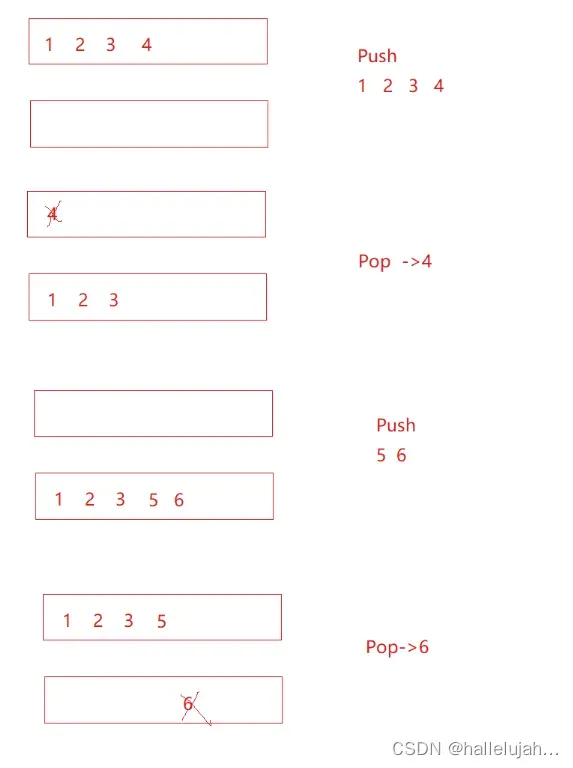
3.3用栈实现队列
OJ
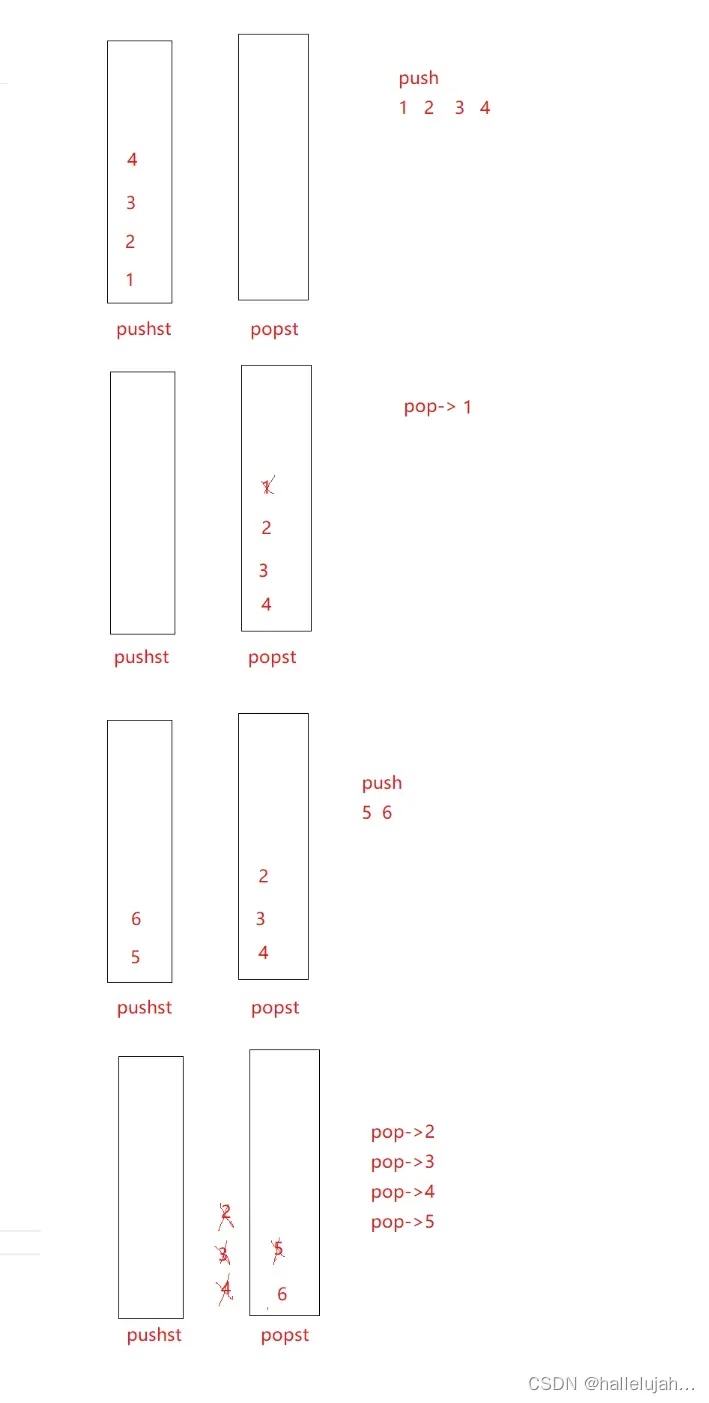
#include<stdio.h>
#include<stdlib.h>
#include<assert.h>
#include<stdbool.h>
typedef int STDateType;
typedef struct Stack
{
STDateType* a;
int top;
int capacity;
}ST;
//初始化
void STInit(ST* ps);
//销毁
void STDestroy(ST* ps);
//入栈
void STPush(ST* ps, STDateType x);
//出栈
void STPop(ST* ps);
//栈顶
STDateType SLTTop(ST* ps);
//计算大小
int STSize(ST* ps);
//判断是否为空
bool STEmpty(ST* ps);
//初始化
void STInit(ST* ps)
{
assert(ps);
ps->capacity = NULL;
ps->a = 0;
ps->top = 0;
}
//销毁
void STDestroy(ST* ps)
{
assert(ps);
free(ps->a);
ps->a = NULL;
ps->capacity = ps->top = 0;
}
//入栈
void STPush(ST* ps, STDateType x)
{
assert(ps);
if (ps->top == ps->capacity)
{
int NewCapacity = ps->capacity == 0 ? 4 : ps->capacity * 2;
STDateType* tmp = (STDateType*)realloc(ps->a, sizeof(STDateType) * NewCapacity);
if (tmp == NULL)
{
perror("realloc fail");
exit(-1);
}
ps->a = tmp;
ps->capacity = NewCapacity;
}
ps->a[ps->top] = x;
ps->top++;
}
//出栈
void STPop(ST* ps)
{
assert(ps);
assert(ps->a > 0);
--ps->top;
}
//栈顶
STDateType STTop(ST* ps)
{
assert(ps);
assert(ps->a > 0);
return ps->a[ps->top - 1];
}
//计算
int STSize(ST* ps)
{
assert(ps);
return ps->top;
}
//判断是否为空
bool STEmpty(ST* ps)
{
assert(ps);
return ps->top == NULL;
}
typedef struct
{
ST pushst;
ST popst;
} MyQueue;
MyQueue* myQueueCreate()
{
MyQueue* obj = (MyQueue*)malloc(sizeof(MyQueue));
STInit(&obj->popst);
STInit(&obj->pushst);
return obj;
}
void myQueuePush(MyQueue* obj, int x)
{
STPush(&obj->pushst, x);
}
int myQueuePeek(MyQueue* obj)
{
if (STEmpty(&obj->popst))
{
while (!STEmpty(&obj->pushst))
{
STPush(&obj->popst, STTop(&obj->pushst));
STPop(&obj->pushst);
}
}
return STTop(&obj->popst);
}
int myQueuePop(MyQueue* obj)
{
int front = myQueuePeek(obj);
STPop(&obj->popst);
return front;
}
bool myQueueEmpty(MyQueue* obj)
{
return STEmpty(&obj->popst) && STEmpty(&obj->pushst);
}
void myQueueFree(MyQueue* obj)
{
STDestroy(&obj->popst);
STDestroy(&obj->pushst);
free(obj);
}
3.4设计循环队列
OJ
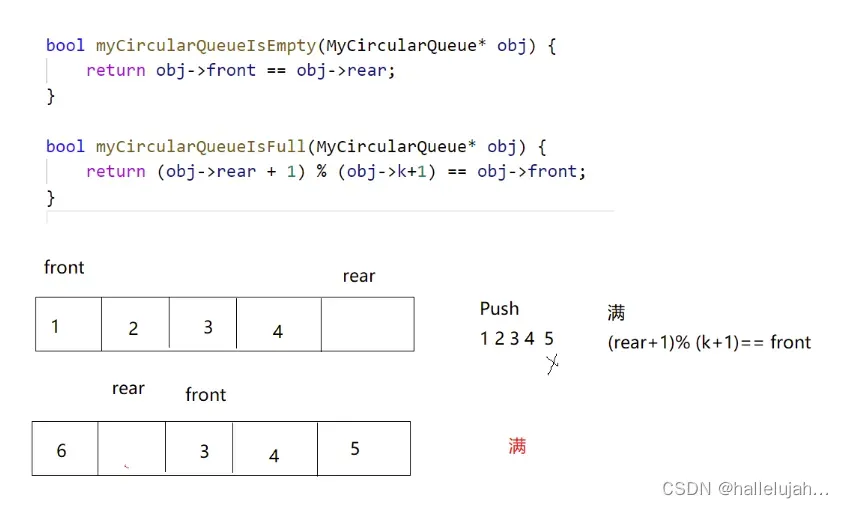
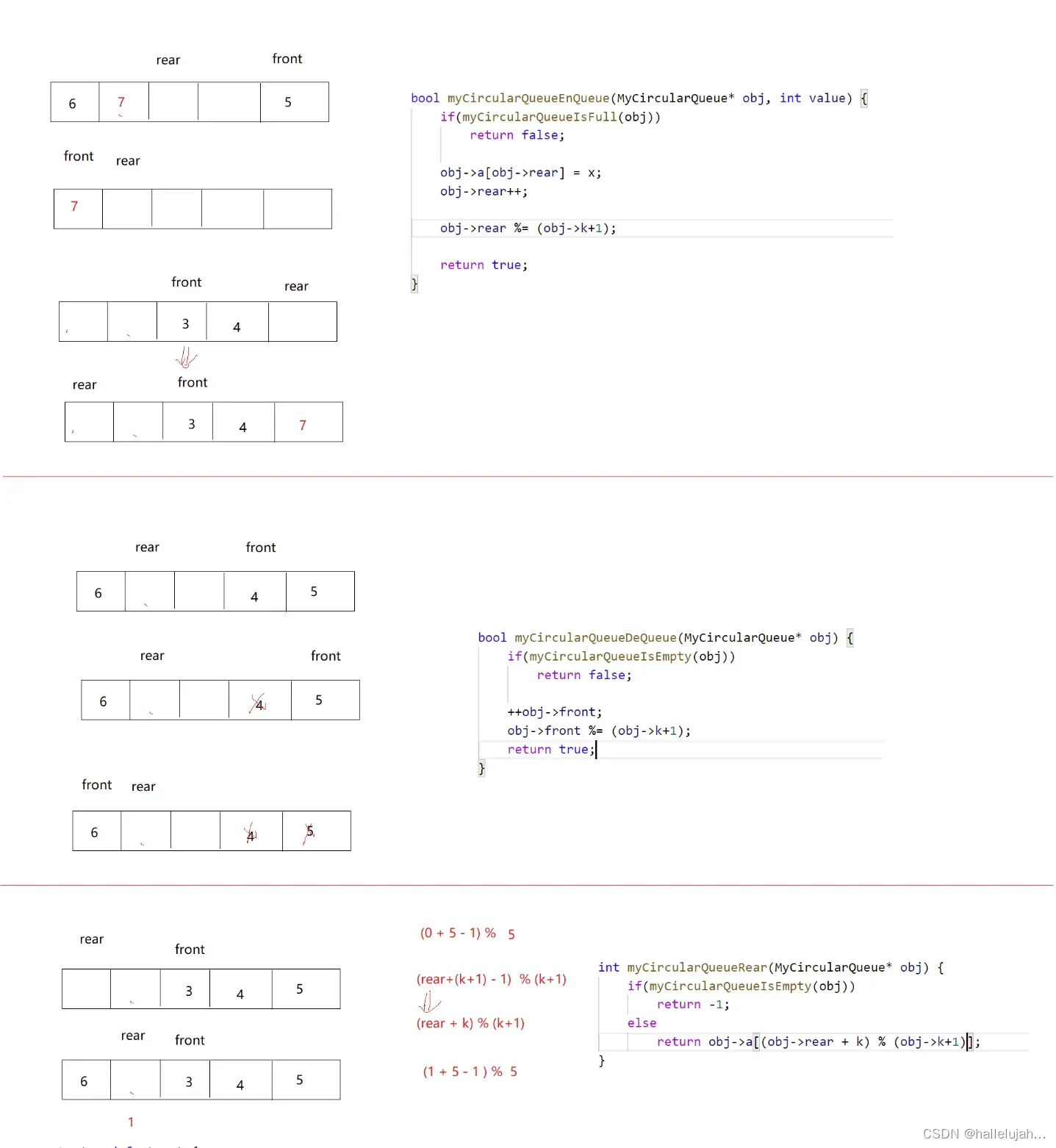
#include<stdio.h>
#include<stdlib.h>
#include<assert.h>
#include<stdbool.h>
//计循环队列
typedef struct
{
int* a;
int front;
int rear;
int k;
} MyCircularQueue;
MyCircularQueue* myCircularQueueCreate(int k)
{
MyCircularQueue* obj = (MyCircularQueue*)malloc(sizeof(MyCircularQueue));
obj->a = (int*)malloc(sizeof(int) * (k + 1));
obj->front = obj->rear = 0;
obj->k = k;
return obj;
}
bool myCircularQueueIsEmpty(MyCircularQueue* obj)
{
return obj->front == obj->rear;
}
bool myCircularQueueIsFull(MyCircularQueue* obj)
{
return (obj->rear + 1) % (obj->k + 1) == obj->front;
}
bool myCircularQueueEnQueue(MyCircularQueue* obj, int value)
{
if (myCircularQueueIsFull(obj))
return false;
obj->a[obj->rear] = value;
obj->rear++;
obj->rear %= (obj->k + 1);
return true;
}
bool myCircularQueueDeQueue(MyCircularQueue* obj)
{
if (myCircularQueueIsEmpty(obj))
return false;
obj->front++;
obj->front %= (obj->k + 1);
return true;
}
int myCircularQueueFront(MyCircularQueue* obj)
{
if (myCircularQueueIsEmpty(obj))
return -1;
return obj->a[obj->front];
}
int myCircularQueueRear(MyCircularQueue* obj)
{
if (myCircularQueueIsEmpty(obj))
return -1;
return obj->a[(obj->rear + obj->k) % (obj->k + 1)];
}
void myCircularQueueFree(MyCircularQueue* obj)
{
free(obj->a);
free(obj);
}
💘不知不觉,【数据结构初阶】栈和队列以告一段落。通读全文的你肯定收获满满,让我们继续为数据结构学习共同奋进!!!
文章出处登录后可见!
已经登录?立即刷新
